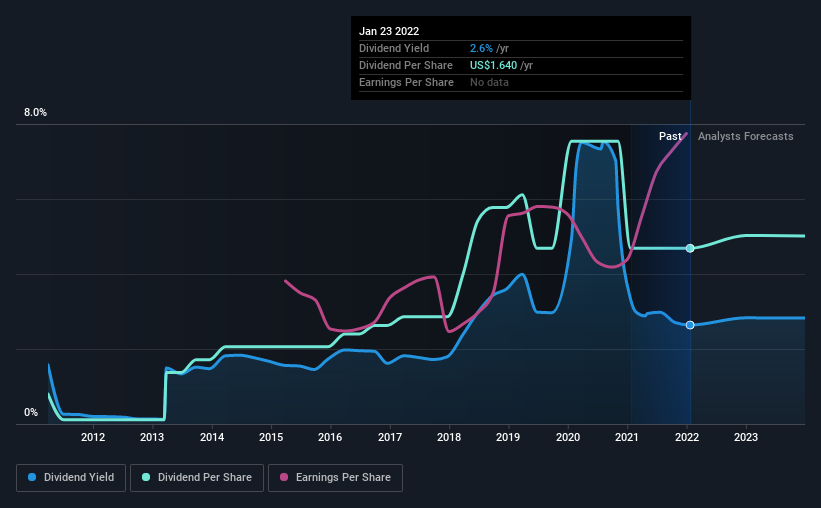- United States
- /
- Banks
- /
- NasdaqGS:BANR
Banner (NASDAQ:BANR) Is Paying Out A Larger Dividend Than Last Year

Banner Corporation (NASDAQ:BANR) will increase its dividend on the 14th of February to US$0.44, which is 7.3% higher than last year. Based on the announced payment, the dividend yield for the company will be 2.7%, which is fairly typical for the industry.
View our latest analysis for Banner
Banner's Payment Has Solid Earnings Coverage
Solid dividend yields are great, but they only really help us if the payment is sustainable. However, Banner's earnings easily cover the dividend. As a result, a large proportion of what it earned was being reinvested back into the business.
Over the next year, EPS is forecast to fall by 20.1%. If the dividend continues along the path it has been on recently, we estimate the payout ratio could be 40%, which is comfortable for the company to continue in the future.

Dividend Volatility
The company's dividend history has been marked by instability, with at least 1 cut in the last 10 years. Since 2012, the first annual payment was US$0.28, compared to the most recent full-year payment of US$1.64. This works out to be a compound annual growth rate (CAGR) of approximately 19% a year over that time. Despite the rapid growth in the dividend over the past number of years, we have seen the payments go down the past as well, so that makes us cautious.
The Dividend Looks Likely To Grow
With a relatively unstable dividend, it's even more important to see if earnings per share is growing. It's encouraging to see Banner has been growing its earnings per share at 18% a year over the past five years. Growth in EPS bodes well for the dividend, as does the low payout ratio that the company is currently reporting.
We Really Like Banner's Dividend
Overall, a dividend increase is always good, and we think that Banner is a strong income stock thanks to its track record and growing earnings. The distributions are easily covered by earnings, and there is plenty of cash being generated as well. However, it is worth noting that the earnings are expected to fall over the next year, which may not change the long term outlook, but could affect the dividend payment in the next 12 months. Taking this all into consideration, this looks like it could be a good dividend opportunity.
Investors generally tend to favour companies with a consistent, stable dividend policy as opposed to those operating an irregular one. Meanwhile, despite the importance of dividend payments, they are not the only factors our readers should know when assessing a company. Just as an example, we've come across 3 warning signs for Banner you should be aware of, and 1 of them is significant. Looking for more high-yielding dividend ideas? Try our curated list of strong dividend payers.
Valuation is complex, but we're here to simplify it.
Discover if Banner might be undervalued or overvalued with our detailed analysis, featuring fair value estimates, potential risks, dividends, insider trades, and its financial condition.
Access Free AnalysisHave feedback on this article? Concerned about the content? Get in touch with us directly. Alternatively, email editorial-team (at) simplywallst.com.
This article by Simply Wall St is general in nature. We provide commentary based on historical data and analyst forecasts only using an unbiased methodology and our articles are not intended to be financial advice. It does not constitute a recommendation to buy or sell any stock, and does not take account of your objectives, or your financial situation. We aim to bring you long-term focused analysis driven by fundamental data. Note that our analysis may not factor in the latest price-sensitive company announcements or qualitative material. Simply Wall St has no position in any stocks mentioned.
About NasdaqGS:BANR
Banner
Operates as the bank holding company for Banner Bank that engages in the provision of commercial banking and financial products and services to individuals, businesses, and public sector entities in the United States.
Flawless balance sheet with solid track record.
Similar Companies
Market Insights
Community Narratives


